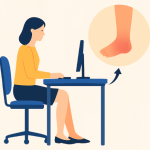Home to the largest muscles in the body, our legs are simply not designed for long periods of inactivity, which is why desk work can be so hard on the lower extremities and prevent proper circulation.
However, there are serval practical things office workers, whether hybrid, home, or HQ-based, can do to improve blood flow to and from the legs, even whilst sitting behind a desk and chipping away at the day’s workload!
Read on to learn a bit about the science behind poor circulation, and to explore ergonomic, stretching, and lifestyle solutions to get the blood flowing properly.
The science of sitting: Why desk work limits blood circulation in the legs
Normally, walking or moving contracts the large muscles in your legs, squeezing blood back toward the heart and keeping circulation flowing.
When those muscles are idle, the pumping effect they trigger grinds to a halt, meaning blood moves more slowly, veins can become compressed, and fluid can accumulate in the lower legs.
Over time, this sluggish blood flow can lead to swelling, leg fatigue, cramps, and even the formation of varicose veins. Prolonged poor circulation can contribute to long-term vascular strain and increase the risk of more serious complications.
Understanding how sitting affects blood flow is the first step toward protecting your leg health, especially for office workers who spend most of their day at a desk.
Explore 10 warning signs of bad circulation in the legs.
The ergonomics factor: Adjusting your workstation for better leg circulation
Your desk, chair, and posture aren’t just about comfort; they play a key role in keeping blood flowing. Small adjustments can make a big difference for leg circulation, preventing swelling, fatigue, and long-term vascular issues.
- Chair choice and height
-
- Ensure your chair supports your lower back while allowing your knees to bend at roughly 90 degrees.
- Your feet should rest flat on the floor; if they don’t, use a footrest.
- Avoid chairs that pinch behind the knees, as this can compress veins and slow blood flow.
- Footrests
-
- A footrest can help keep your feet supported, improve posture, and relieve pressure on the legs.
- Using a footrest to elevate your legs reduces the resistance of gravity on blood flow.
- Even small foot movements on the rest, like rocking your heels, stimulate circulation.
- Standing desks and sit-stand routines
-
- Alternating between sitting and standing every 30–60 minutes encourages blood flow and activates leg muscles.
- If a full standing desk isn’t available, try short standing breaks or walking to a colleague’s desk instead of emailing.
- Avoid static leg postures
-
- Try subtle movements: flex and extend your ankles, tap your feet, or shift your weight periodically to keep blood moving. Even small exercises can make a big difference over time.
A few simple adjustments to your workstation can make a huge difference in circulation, comfort, and long-term leg health.
Need expert guidance? Our ergonomics specialists can assess your desk setups and provide detailed recommendations to improve circulation, prevent musculoskeletal injuries, minimize digital eye, and bolster productivity. Contact us today to get started.
Related: Learn how to position your computer monitor for sustainable working
Simple exercises to improve leg circulation at your desk
Just a few minutes of movement every hour can help keep blood flowing and reduce the impact of long sitting periods. Here are some exercises you can do either without leaving your chair or without leaving the office.
- Seated leg lifts / extensions
-
- Sit upright and slowly extend one leg until it’s parallel to the floor.
- Hold for 5–10 seconds, then lower.
- Repeat 10 times per leg. This engages your thigh muscles and encourages blood flow.
- Ankle pumps
-
- While seated, flex your feet up toward your shins, then point them down.
- Repeat 15–20 times per foot. This helps stimulate circulation in the lower legs and calves.
- Ankle rotations
-
- Lift one foot slightly off the floor and rotate your ankle clockwise and counterclockwise.
- Do 10 rotations in each direction per foot. This stimulates the calf muscles and helps move blood through the veins.
- Heel raises / calf raises
-
- Stand behind your chair or at your desk, lift your heels while keeping your toes on the ground, then lower slowly.
- Repeat 15–20 times. This activates the calf “muscle pump,” a key mechanism for returning blood from the legs to the heart.
- Calf stretches
-
- Stand and place your hands on the back of your chair or desk.
- Step one foot back and press the heel into the floor to stretch your calf.
- Hold for 15–20 seconds per leg. Stretching improves flexibility and circulation.
- Short walking breaks
-
- Whenever possible, get up and walk around for 2–5 minutes every hour.
- Even a quick stroll to the printer, water cooler, or around the office can dramatically improve blood flow and reduce stiffness.
Pro tip: Set a timer or reminder to move regularly. Small, consistent actions throughout the day are far more effective than occasional long walks.
Lifestyle tips for improving blood circulation in the legs
What you do outside of work plays a big role in maintaining healthy blood flow in your legs. Small, consistent lifestyle choices can complement your desk-friendly exercises and workstation adjustments.
- Stay active
-
- Regular aerobic exercise, like walking, cycling, swimming, or even light jogging, keeps your heart and veins strong and encourages efficient blood flow.
- Aim for at least 30 minutes of moderate activity most days of the week.
- Hydration
-
- Drinking enough water keeps your blood less viscous and easier to circulate.
- Dehydration can thicken blood and make sluggish circulation worse.
- Diet matters
-
- Limit excess sodium, which can contribute to fluid retention and swelling in the legs.
- Eat foods that support vascular health, like fruits, vegetables, whole grains, and healthy fats.
- Maintain a healthy weight
-
- Extra body weight increases pressure on the veins in your legs, making circulation more difficult.
- Combining a balanced diet with regular activity can relieve stress on your legs and improve overall vascular health.
- Avoid prolonged inactivity outside work
-
- Even after leaving your desk, avoid sitting for long periods. Use TV commercial breaks or phone calls as opportunities to move.
When workstation and lifestyle adjustments aren’t enough to address circulatory issues
While ergonomic setups, exercises, and healthy habits go a long way, there are times when these measures aren’t sufficient. Persistent or severe symptoms may indicate underlying circulation or vascular issues that require professional attention.
Watch for red flags such as:
- Swelling or pain that doesn’t improve with rest or elevation
- Numbness or tingling that is frequent or long-lasting
- Slow-healing cuts, sores, or bruises
- Severe or worsening leg pain or cramping
- Significant skin changes, including discolored areas and ulcers
If you notice any of these warning signs, it’s important to consult a healthcare professional promptly. Early detection can prevent complications and help manage conditions like peripheral artery disease, deep vein thrombosis, or chronic venous insufficiency.
Work healthier with Cardinus
At Cardinus, we specialize in office ergonomics solutions designed to keep your team comfortable, healthy, and productive.
Whether you need comprehensive workstation assessments, specialized training courses, an office ergonomics program through our Healthy Working software, or a fully managed ergonomics service, we can help.
Contact the team today to discuss solutions tailored to your office and your people.





